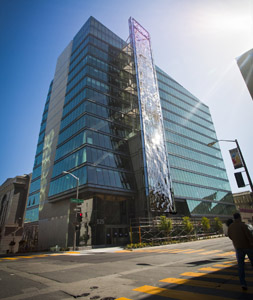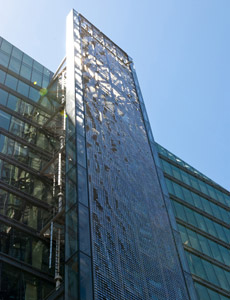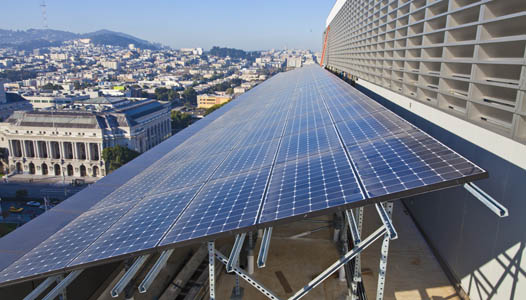It seems just about every building construction project in San Francisco is vying to be the Cityís greenest, but designers and builders have some work to do if they want to beat the San Francisco Public Utilities Commissionís (SFPUC) new digs on Golden Gate Avenue.

The front of the SFPUC headquarters was redesigned so that a curvature forces a channel of wind past vertical wind turbines. The original design included rooftop turbines, which were omitted after UC Davis engineers determined that the wind was inconsistent due to large buildings in the area. The turbines on the roof were replaced with solar panels. Photo Courtesy of the San Francisco Public Utilities Commission
By Bill Picture
Published: July, 2012
It seems just about every building construction project in San Francisco is vying to be the City’s greenest, but designers and builders have some work to do if they want to beat the San Francisco Public Utilities Commission’s (SFPUC) new digs on Golden Gate Avenue.
The 13-story building, which opened June 20, sets arguably the greenest example to date in the Bay Area for innovative design and construction. The building is so advanced in design and technology that it is expected to become a tourist attraction.
The site on which the new building stands was home to state offices until 1989, when the Loma Prieta Earthquake rendered the former building uninhabitable. The building then sat idle for 10 years, before then-Mayor Willie Brown convinced the state to sell the property to the City of San Francisco for $2.
"It was a real eyesore," said SFPUC Communications Director Tyrone Jue. "Most of the windows were busted out, and there was graffiti all over the building. Leave it to Mayor Brown to have the foresight to say, ‘Hey, if you’re not going to do anything with it, how about you give it to us.’"
Boom, bust, crash and beyond
The City didn’t have a plan for its newly acquired piece of prime Civic Center real estate at the time of the sale, but the SFPUC, which had been renting office space in two nearby buildings, had its eye on the property and assembled a project team to crunch the numbers.
"Remember, this is 1999 we’re talking about. Do you remember what happened in 1999? Boom!" exclaimed Jue.
The Bay Area became the heart of the hi-tech industry and the price of just about everything, including construction, went through the roof. As a result, the SFPUC determined it was cheaper for the agency to stay put in its rented offices. When the dot-com industry went bust a few years later, inflated prices began to come down, so the agency’s head had his team run the figures for the new building again. Alas, it was still too expensive.
It wasn’t until 2009, when the real estate market crashed, that the plan would get off the ground. Anxious to work, construction firms began lowering their prices and aggressively bidding on new projects.
"That’s about the time that [General Manager] Ed Harrington came onboard," Jue said. He looked around, saw what was happening out there and said, ‘Let’s try this one more time, shall we.’"
The drop in construction prices, coupled with some tweaks made to the original building design to bring down its price tag, made the project suddenly feasible. "We estimated that the project would actually save taxpayers $3.7 billion over the next ten years," Jue said. "Finally, the SFPUC was going to have a permanent home." Ground was broken later that year.
Ch-ch-ch-ch-changes
Though some changes were made to the original design to cut costs, the lion’s share of the building’s green elements survived the cuts. Those elements showcase the very latest in green-building technology, and, according to Jue, represent the SFPUC’s mission to be an environmental leader.
"We wanted to build a building that we as an agency could be proud of, and that the City of San Francisco could be proud of," he said. "I think we exceeded even our own expectations."
For instance, a state-of-the-art raised flooring system reduces the amount of energy needed for heating, cooling and ventilation by 51 percent. The building also features a "living machine" that mimics a natural wetland’s multi-step filtering process by using plants and microorganisms to treat reclaimed wastewater for use in the building’s flush toilets. And a rainwater harvesting system will store enough water to take care of exterior irrigation needs.
Though cost-cutting measures in the design and construction phase usually bring a building down a few green notches, the changes made in the final plan ended up significantly improving the SFPUC headquarters’ overall green portfolio.
The first was forgoing a traditional steel frame and instead using reconstituted concrete mixed with byproducts of coal and steel, all materials that would otherwise be bound for landfills. The change saved the SFPUC enough money that it was able to add another story to the building. The concrete mixture also lightens as it ages (unlike traditional concrete, which turns a dark gray) and will reflect light, reducing the need for artificial light.
The second was a major change to the plan for generating renewable energy on-site. The original plan called for lots and lots of roof-mounted wind turbines.
"UC Davis came out and measured the wind patterns, and they determined that the wind is inconsistent because of all the tall buildings in the area," Jue said. "So we decided to do solar panels instead, which would be more effective and cost much less."
Determined to retain some of the building’s wind-power-generating capability, however, designers added a curvature to the front of the building to create a channel of wind that spins four vertical turbines. "The project team told us ours was the third-most-difficult project they’ve ever worked on," Jue said. "But it was well worth the extra time and effort."
Art, art everywhere
The SFPUC made sure that visitors, along with the agency’s 950 employees, who’ve already begun moving in, would have plenty of pretty things to admire. As required by the City of San Francisco, the equivalent of 2 percent of the money spent on above-ground construction was used to commission art for public spaces.
In addition to 40-foot-tall interactive displays (created by SF-based digital firm Obscura) in the lobby, the building also features works of fine art from nearly 100 local artists. The building’s signature piece, which was created by Ed Kahn—one of two that he created for the SFPUC—consists of 15,000 clear polycarbonate panels that sheath the façade and move with the passing wind. As the panels move, they touch a magnet and trigger a small LED light.
"We call it ‘firefly,’" said Jue. "I was driving by the other night and saw it moving, and the lights glowing as the wind moved the panels. It’s really stunning."
"I think this building stands for everything we are and value as an agency and as a city," he continued. "And we couldn’t be more excited about sharing it with visitors."
For more information, visit www.sfwater.org.
.

The facade of the SF Public Utilities Commissionís super-green new headquarters features 55,000 polycarbonate panels that move with the wind. When the panels move, they touch a magnet and a tiny LED light goes on, mimicking the glow of thousands of fireflies. The stunning work of art was created by Bay Area artist Ed Kahn. Photo Courtesy of the San Francisco Public Utilities Commission

The carbon footprint of the new SFPUC headquarters, which were unveiled on June 20, is 51 percent smaller than most buildings its size thanks to dozens of green elements, including rooftop solar panels. Photo Courtesy of the San Francisco Public Utilities Commission

